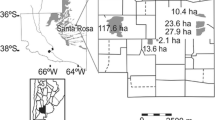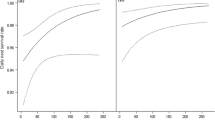Abstract
Increasing rates of nest predation is one of several hypotheses proposed to explain observed declines of Wood Warbler Phylloscopus sibilatrix populations in the UK. Nest predation may be influenced by how nest concealment is affected by vegetation structure, which may vary between breeding sites. Detailed nest monitoring within three study areas with varying population trends identified the main nest predators and predation as the main cause of nest failure. Comparison of habitat structure surrounding nests with non-nest locations within territories showed that nests were placed on steeper slopes, in areas with a taller canopy, intermediate understorey density, greater cover of bramble and intermediate cover of tall field layer vegetation. Predation rates were related to field layer structure with lower predation rates associated with greater cover of medium-height vegetation. However, the size of the effect of vegetation on predation rates was small, and vegetation management is unlikely to have a strong impact on predation rates except in extreme cases of very low ground cover.
Zusammenfassung
Nestraub und der Einfluss der Habitatstruktur auf die Nestprädation beim Waldlaubsänger Phylloscopus sibilatrix , einem bodenbrütenden Waldsingvogel
Ein Anstieg der Nestprädationsraten ist eine von mehreren Hypothesen, mit denen versucht wird, den zu beobachtenden Populationsrückgang beim Waldlaubsänger Phylloscopus sibilatrix im Vereinigten Königreich zu erklären. Die Nestprädation kann dadurch beeinflusst werden, inwieweit die Vegetationsstruktur, welche sich von Neststandort zu Neststandort unterscheidet, Auswirkungen auf die Nesttarnung hat. Durch ausführliches Nestmonitoring in drei Untersuchungsgebieten mit verschiedenen Populationstrends konnten die primären Nestprädatoren ermittelt und Nestraub als die Hauptursache für Brutverluste ausgemacht werden. Durch den Vergleich der Habitatstruktur in Nestumgebung mit der an Stellen ohne Nester innerhalb der Reviere zeigte sich, dass sich Nester an steileren Hängen befanden, in Gegenden mit höherem Kronendach, mittlerer Unterwuchsdichte, stärkerem Bewuchs mit Brombeere und einem mittleren Bedeckungsgrad durch hohe krautige Vegetation. Die Prädationsraten waren von der Krautschicht abhängig, insofern als niedrigere Prädationsraten in Verbindung mit einem stärkeren Bewuchs durch Pflanzen mittlerer Höhe auftraten. Allerdings war das Ausmaß des Vegetationseinflusses auf die Prädation nur schwach, und das Vegetationsmanagement wird außer in extremen Fällen mit sehr geringer Bodenbedeckung kaum eine starke Auswirkung auf die Prädationsraten haben.


Similar content being viewed by others
Change history
05 May 2018
In the original publication of the article, there is a misalignment of the last two columns in table 2. The correct Table 2 is provided below.
References
Amar A, Hewson C, Thewlis R, Smith KW, Fuller RJ, Lindsell J, Conway G, Butler S, MacDonald M (2006) What’s happening to our woodland birds? Long-term changes in the populations of woodland birds. RSPB research report 19/BTO research report 169. RSPB/BTO, Sandy/Thetford
Balmer D, Gillings S, Caffrey BJ, Swann RL, Downie IS, Fuller RJ (2013) Bird atlas 2007–11: the breeding and wintering birds of Britain and Ireland. BTO, Thetford
Barton K (2014) MuMIn: multi-model inference. R package version 1.10.5. http://CRAN.R-project.org/package=MuMIn
Bates D, Maechler M, Bolker B, Walker S (2015) Fitting linear mixed-effects models using lme4. J Stat Softw 67:1–48
Bolton M, Butcher N, Sharpe F, Stevens DK, Fisher G (2007) Remote monitoring of nests using digital camera technology. J Field Ornithol 78:213–220
Braden GT (1999) Does nest placement affect the fate or productivity of California Gnatcatcher nests? Auk 116:984–993
Charman EC, Smith KW, Dodd S, Gruar DJ, Dillon IA (2012) Pre-breeding foraging and nest site habitat selection by Lesser Spotted Woodpeckers Dendrocopos minor in mature woodland blocks in England. Ornis Fenn 89:182–196
Cody ML (1978) Habitat selection and interspecific territoriality among the sylviid warblers of England and Sweden. Ecol Monogr 48:351–396
Delahaye L, Vandevyvre X (2008) Le Pouillot siffleur (Phylloscopus sibilatrix) est-il une espece indicatrice de la qualite des forets feuillues ardennaises? Aves 45:3–14
Eggers S, Griesser M, Andersson T, Ekman J (2005) Nest predation and habitat change interact to influence Siberian Jay numbers. Oikos 111:150–158
Evans KL (2004) The potential for interactions between predation and habitat change to cause population declines of farmland birds. Ibis 146:1–13
Fletcher K, Aebischer NJ, Baines D, Foster R, Hoodless AN (2010) Changes in breeding success and abundance of ground-nesting moorland birds in relation to the experimental deployment of legal predator control. J Appl Ecol 47(2):263
Flowerdew JR, Shore RF, Poulton SMC, Sparks TH (2004) Live trapping to monitor small mammals in Britain. Mamm Rev 34:131–150
Forstmeier W, Weiss I (2004) Adaptive plasticity in nest-site selection in response to changing predation risk. Oikos 104:487–499
Fuller RJ, Gough SJ (1999) Changes in sheep numbers in Britain: implications for bird populations. Biol Cons 91:73–89
Fuller RJ, Noble D, Smith KW, Vanhinsbergh D (2005) Recent declines in populations of woodland birds in Britain: a review of possible causes. Br Birds 98:116–143
Gregory RD, Vorisek P, Van Strien A, Gmelig-Meyling AW, Jiguet F, Fornasari L, Burfield IJ (2007) Population trends of widespread woodland birds in Europe. Ibis 149(s2):78–97
Grendelmeier A, Arlettaz R, Gerber M, Pasinelli G (2015) Reproductive performance of a declining forest passerine in relation to environmental and social factors: implications for species conservation. PLoS One 10:e0130954
Harris SJ, Massimino D, Newson SE, Eaton MA, Marchant JH, Balmer DE, Noble DG, Gillings S, Procter D, Pearce-Higgins JW (2016) The Breeding Bird Survey 2015. BTO research report 687. British Trust for Ornithology, Thetford
Hazler KR (2004) Mayfield logistic regression: a practical approach for analysis of nest survival. Auk 121:707–716
Huber N, Kienast F, Ginzler C, Pasinelli G (2016) Using remote-sensing data to assess habitat selection of a declining passerine at two spatial scales. Landsc Ecol 31:1919–1937
Lahti DC (2001) The “edge effect on nest predation” hypothesis after twenty years. Biol Cons 99:365–374
Larivière S (1999) Reasons why predators cannot be inferred from nest remains. Condor 101:718–721
Macdonald MA, Bolton M (2008) Predation on wader nests in Europe. Ibis 150:54–73. https://doi.org/10.1111/j.1474-919X.2008.00869.x
Mallord JW, Charman EC, Cristinacce A, Orsman CJ (2012a) Habitat associations of Wood Warblers Phylloscopus sibilatrix breeding in Welsh oakwoods. Bird Study 59:403–415
Mallord JW, Orsman CJ, Cristinacce A, Butcher N, Stowe TJ, Charman EC (2012b) Mortality of Wood Warbler Phylloscopus sibilatrix nests in Welsh oakwoods: predation rates and the identification of nest predators using miniature nest cameras. Bird Study 59:286–295
Mallord JW, Smith KW, Bellamy PE, Charman EC, Gregory RD (2016) Are changes in breeding habitat responsible for recent population changes of long-distance migrant birds? Bird Study 63:250–261. https://doi.org/10.1080/00063657.2016.1182467
Martin TE (1993) Nest predation and nest sites. Bioscience 43:523–553
Martin JL, Joron M (2003) Nest predation in forest birds: influence of predator type and predator’s habitat quality. Oikos 102:641–653
Martin TE, Roper JJ (1988) Nest predation and nest-site selection of a western population of the Hermit Thrush. Condor 90:51–57
Mercer I (2009) Dartmoor. A statement of its time. New Naturalist 111
Newton I (1998) Population limitation in birds. Academic Press, London
Pasinelli G, Grendelmeier A, Gerber M, Arlettaz R (2016) Rodent-avoidance, topography and forest structure shape territory selection of a forest bird. BMC Ecol 16:1–18
Peterken G, Tubbs C (1965) Woodland regeneration in the new forest, Hampshire, since 1650. J Appl Ecol 2:159–170
R Core Team (2015) R3.2.1: a language and environment for statistical computing. R Foundation for Statistical Computing, Vienna. http://www.R-project.org/
Rangen SA, Clark RG, Hobson KA (1999) Influence of nest-site vegetation and predator community on the success of artificial songbird nests. Can J Zool 77:1676–1681
Robinson RA (2017) BirdFacts: profiles of birds occurring in Britain and Ireland (BTO research report 407). BTO, Thetford. http://www.bto.org/birdfacts. Accessed on 23 Jan 2017
Robinson RA, Leech DI, Massimino D, Woodward I, Hammond MJ, Harris SJ, Noble DG, Walker RH, Eglington SM, Marchant JH, Sullivan MJP, Baillie SR (2016) BirdTrends 2016: trends in numbers, breeding success and survival for UK breeding birds. Research report 691. BTO, Thetford. http://www.bto.org/birdtrends
Roos S, Pärt T (2004) Nest predators affect spatial dynamics of breeding Red-backed Shrikes (Lanius collurio). J Anim Ecol 73:117–127. https://doi.org/10.1111/j.1365-2656.2004.00786.x
Schmidt KA (2003) Nest predation and population declines in Illinois songbirds: a case for mesopredator effects. Conserv Biol 17:1141–1150. https://doi.org/10.1046/j.1523-1739.2003.02316.x
Tapper S, Potts G, Brockless M (1996) The effect of an experimental reduction in predation pressure on the breeding success and population density of Grey Partridges Perdix perdix. J Appl Ecol 33:965–978. https://doi.org/10.2307/2404678
Tuomenpuro J (1991) Effect of nest site on nest survival in the Dunnock Prunella modularis. Ornis Fenn 68:49–56
Welsh Government (2015) June 2015 survey of agriculture and horticulture: results for Wales. http://gov.wales/docs/statistics/2015/151119-survey-agriculture-horticulture-june-2015-en.pdf
Wesolowski T (1985) The breeding ecology of the wood warbler phylloscopus sibilatrix in primaeval forest. Ornis Scand 16(1):49
Wesolowski T, Maziarz M (2009) Changes in breeding phenology and performance of Wood Warblers Phylloscopus sibilatrix in a primeval forest: a thirty-year perspective. Acta Ornithol 44:69–80
Wesolowski T, Rowinski P, Maziarz M (2009) Wood Warbler Phylloscopus sibilatrix: a nomadic insectivore in search of safe breeding grounds? Bird Study 56:26–33
White PJ, Stoate C, Szczur J, Norris K (2008) Investigating the effects of predator removal and habitat management on nest success and breeding population size of a farmland passerine: a case study. Ibis 150(s1):178–190
Wiebe KL, Martin K (1998) Costs and benefits of nest cover for Ptarmigan: changes within and between years. Anim Behav 56:1137–1144
Willson MF, Morrison JL, Sieving KE, de Santo TL, Santisteban L, Diaz I (2001) Patterns of predation risk and survival of bird nests in a Chilean agricultural landscape. Conserv Biol 15:447–456
Acknowledgements
This work was funded by Natural England and RSPB under the Action for Birds in England partnership. We would like to thank the many landowners for access to study sites. Derek Gruar and Anna Riach contributed to field data collection in 2009, and Alice Tribe in 2012. All aspects of this study complied with UK law.
Data availability
The datasets analysed during the current study are available from the corresponding author on reasonable request.
Author information
Authors and Affiliations
Corresponding author
Additional information
Communicated by F. Bairlein.
Electronic supplementary material
Below is the link to the electronic supplementary material.
Rights and permissions
About this article
Cite this article
Bellamy, P.E., Burgess, M.D., Mallord, J.W. et al. Nest predation and the influence of habitat structure on nest predation of Wood Warbler Phylloscopus sibilatrix, a ground-nesting forest passerine. J Ornithol 159, 493–506 (2018). https://doi.org/10.1007/s10336-017-1527-7
Received:
Revised:
Accepted:
Published:
Issue Date:
DOI: https://doi.org/10.1007/s10336-017-1527-7




